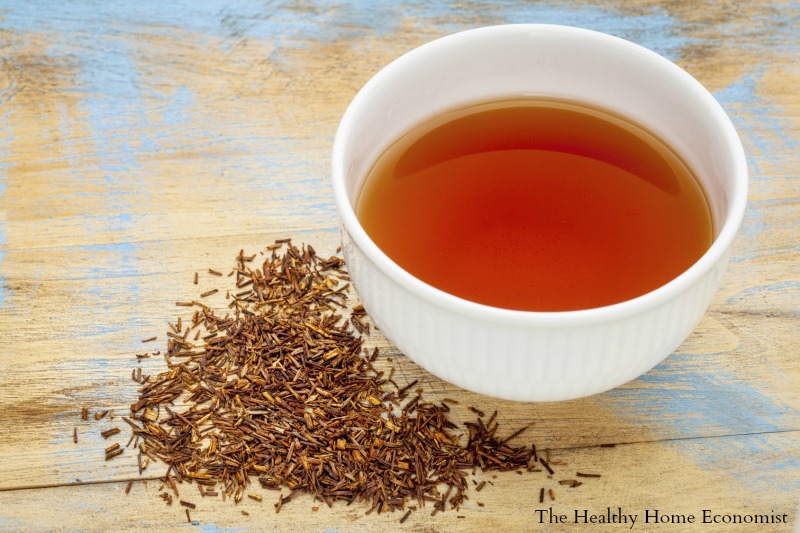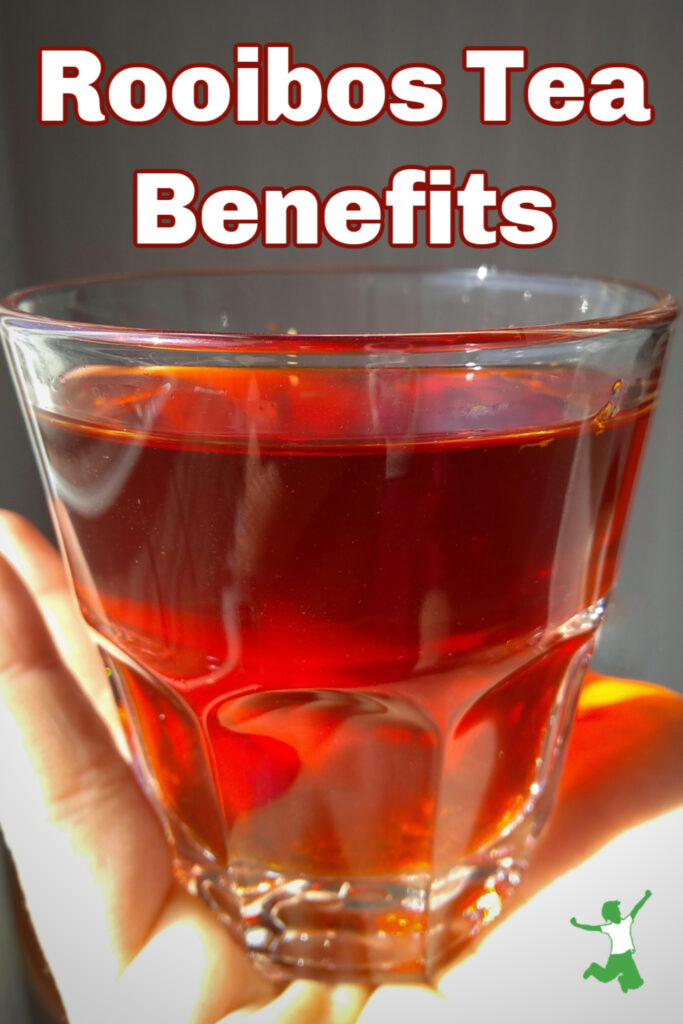Health benefits of rooibos tea and why it’s one of the best substitutes for tea and coffee to reduce adrenal-depleting stimulants in the diet.

I love tea! Like many foodies, my tea cabinet is overflowing with various types so I can always find the right one to fit whatever the need may be at that particular moment.
A little congested? A cup of alfalfa or stinging nettle tea work well due to their natural antihistamine properties.
Stressed out? A cup of chamomile tea will calm you down in no time.
So, where does rooibos fit in?
Rooibos: Herbal Gem from Africa
A cup of rooibos tea, also known as red or redbush tea is one of my favorite caffeine-free beverages.
While I love green tea, I can’t drink it every day as I am so sensitive to caffeine.
Even small amounts on a daily basis can weaken the adrenals sometimes with odd symptoms and contribute to early afternoon fatigue or worse over time.
I really can only enjoy caffeinated tea occasionally. Have you noticed how a daily dose of caffeine quickly develops into a habit if you’re not especially careful?
I don’t prefer decaffeinated black or green tea because, to me, this is an unnatural over-processing of these herbs. They just don’t taste the same in my opinion.
I would rather choose a tea that is naturally caffeine free.
Rooibos tea (my preferred source) is native to the continent of Africa and is primarily grown in South Africa’s Western Cape.
Local people have traditionally used it for centuries.
Dutch settlers in South Africa used it as an alternative to expensive black tea whose supply was dependent on trading ships from Europe.
Flavor and Nutrition
Red tea has an earthy and slightly nutty flavor. The first time I tried a cup, I didn’t really care for it much to be honest!
Rooibos definitely grows on you after a while, and now, I simply love it!
One of the biggest flavor bonuses is that unlike black or green teas, matcha and yerba maté, rooibos does not become bitter.
Instead, it becomes sweeter with an even more enjoyable flavor with extended brewing.
Thus, it is especially enjoyable as a therapeutic herbal infusion that is brewed overnight.
My favorite way to enjoy it socially is with a sprinkle of cinnamon on top, a la red tea latte.
Health Benefits
Rooibos’ benefits primarily revolve around the fact that it is naturally decaffeinated and loaded with antioxidants.
Scientifically, no adverse effects and many health benefits are attributed to rooibos tea consumption. (1)
Some of the biggest health boons are its anti-fungal and antimutagenic (DNA protective) properties.
It also beneficially modulates the immune system and assists with nervous tension, skin problems, and digestive complaints.
I personally find that a warm cup of red tea gives me a lift in the morning with no caffeine required. This effect is perhaps due to its benefits to the digestive system, as anything that reduces digestive burden results in an improved energy state!
I also love to have rooibos tea on hand because it is a caffeine-free choice for the kids whenever they ask for a cup.
These healthy habits take hold and can stick too! My youngest, who just turned 18, still enjoys a cup of rooibos over more trendy, unhealthful beverages!
Safest Forms of Rooibos Tea
Like many plants, be aware that rooibos readily takes in fluoride from the surrounding soil.
It is very important to make sure you buy organic rooibos as commercial fertilizers contain large amounts of fluoride. (2)
I recommend organic loose-leaf rooibos as the most economical and safe way to enjoy it (such as this source).
Be aware that most tea bags are toxic even if the tea itself is organically certified!
Many tea lovers have no idea about this.
Healthy Substitute for Lattes, Cappuccino and Espresso
“Red espresso” is served in South African coffee shops and is concentrated rooibos served in the same manner as light or dark espresso from coffee beans.
Rooibos tea is delicious with milk and makes an excellent caffeine-free rooibos latte or cappuccino.
Another caffeine-free idea is a dandelion latte if you really enjoy the taste of coffee.
In the summer, iced red tea is a very pleasant alternative to the black iced teas on the market (these bottled teas are very high in fluoride).
For those attempting to shake the coffee or green/black tea habit, a switch to rooibos may be just the ticket!
If you need more caffeine-free beverage ideas, the linked article contains more suggestions and a healthy recipe.

(1) Rooibos Tea and Health: A Systematic Review of the Evidence from the Last
Two Decades
(2) The Phosphate Fertilizer Industry: An Environmental Overview








Hi Sarah,
Another South African here. We make a thermos of Rooibos when we go to bed. It’s lovely and hot when we get up, however if you leave it for a few hours more it does turn bitter. There is also a tea here called honeybush which I think is a form of rooibos.
So enjoy your articles. Keep up the good work!
I really like red rooibos especially in winter, but you can also make it Ice Tea so perfect all year long!
Yes, it makes great iced tea! Thanks for sharing 🙂
I love drinking rooibos tea! Sometimes I steep it with mint as well. There are so many health benefits to herbal teas, I always feel great after drinking them.
Enjoyed reading this lovely article.
Appreciated how kindly you described Rooibos.
I find it very delicious as teas go.
Have enjoyed it for about five years now
Hi Sarah! I’m a bit late to the game on when this was blog post was written, but when I click to see where you source your rooibos, it takes me to the ‘salt’ section of your shopping list page. Can you tell me where you get yours? Thanks!
Never mind 🙂 after searching farther down the page I found the section on teas.
Vanilla rooibos is a place where you can read all about rooibos tea
and how to brew it.
Thanks for the Info!
That is where I grew up – Western Cape – and was raised on RooiBos Tea in many forms and shapes! Bring back many memories!
Many times I use the cold black left-over Tea and mix with fresh frozen Peaches (from my garden) into a Creamy Smoothie! Deliciously! Spear Mint goes well with it, too.
Enjoy some Sunshine and Good Health in a Cup far away from Home! x
I drink a lot of Rooibos tea and I have never thought to do this with left overs. I look forward to giving it a try. Thank you for sharing.
Dear Sarah,
As a native, Afrikaans South African and erstwhile Rooibos farmer – and long-time fan of your blog! – allow me to add a few points: the tea is called “rooibos” and not “rooibus”. The name literally means “red bush”. I mention this because your readers will find tons of useful information about this tea online if you search with the right name.
Someone asked about the pronunciation – don’t rely on the pronunciation guide on Youtube! The one on Wiktionary is a lot better: http://en.wiktionary.org/wiki/rooibos
Please note that almost none of the anti-oxidant or other benefits of Rooibos tea will be realised by perfunctory brewing – this tea LOVES to be brewed at length. Unlike normal English/breakfast/Ceylon/black tea, it does not become bitter – it only becomes sweeter and more lovely with extended brewing.
If you don’t have a teapot that can go on the stovetop for extended brewing, then at least ensure that you brew/steep it in your cup or teapot for at least 5 minutes. Take the necessary steps to ensure that your tea remains warm, e.g. pre-warming the cup/teapot with boiling water, keeping it well covered during brewing (e.g. a saucer over your cup or a tea-cosy over your teapot).
During one happy period of my life I lived on a farm where there was a giant kettle stocked with Rooibos teabags steaming on the wood-burning stove round the clock – we only topped up the water when it ran low and constantly added MORE teabags until the kettle was clogged with bags… after a day or so of this brewing the tea ran dark and sweet – and we quite happily quaffed this without any desire for sweetener or milk. Fantastic stuff.
Even if you end up with cold tea it’s no loss – like you said, it’s also delicious as an iced tea.
This site has some good tips on brewing: http://www.rooibostea.com/proper-brewing-of-rooibos-tea.php
When winter colds and flu threaten my family, they get dosed with the following brew: strong rooibos tea infused with fresh sliced ginger, a squeeze of lemon juice, and a dab of honey. Tastes yummy, warms the innards, and drives off the lurgies.
Lastly, I’d like to point your readers at this article which delves into the many health benefits of Rooibos tea:
http://inhumanexperiment.blogspot.com/2010/04/many-health-benefits-of-rooibos-tea.html
In summary:
– more potent anti-oxidant than green tea
– protection against DNA damage
– cardiovascular benefits
– benefits for diabetes sufferers – and all those concerned about blood glucose levels (which will certainly include all WAP readers!)
– liver tissue regeneration
– lowers blood pressure, acts as bronchidilator and antispasmodic
– inhibits brain aging
… what’s not to like? 🙂
Sunny South African wishes and thanks for all the amazing info you disseminate.